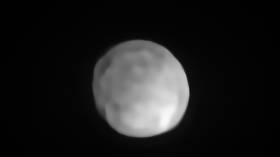Mysterious asteroid may be reclassified as solar system’s smallest dwarf planet

After causing an uproar, which lasts to this day, by reclassifying Pluto in 2006, the International Astronomical Union is now risking a repeat of the controversy as they consider reclassifying an asteroid as a dwarf planet.
Astronomers said Monday that the asteroid Hygiea, which inhabits the asteroid belt between Mars and Jupiter, could soon join Pluto, Ceres, Makemake, Haumea, and Eris, and be considered a dwarf planet after new imaging and data from the European Southern Observatory’s SPHERE instrument on the Very Large Telescope showed Hygiea to be spherical.
Also on rt.com ‘Pluto is a planet’: NASA official risks sparking science civil war with controversial declarationThe shape, along with the surface and size, are key considerations when classifying a celestial object, and these new high resolution images could be a game changer for the oversized space rock.
“Thanks to the unique capability of the SPHERE instrument on the VLT… we could resolve Hygiea’s shape, which turns out to be nearly spherical,” said lead researcher Pierre Vernazza from the Laboratoire d’Astrophysique de Marseille in France.
Hygeia has a diameter of 267 miles across compared with its potential dwarf planet siblings Ceres (590 miles in diameter) and Pluto (1,491 miles in diameter). If reclassified, Hygeia would become the smallest dwarf planet in the solar system.
Also on rt.com Dinosaur killing asteroid caused mass extinction by turning oceans ACIDICIn order to be a dwarf planet, the object must orbit around the Sun and must not be a moon. It must also be moulded by its own gravity into a round or nearly round shape, and must interact with the smaller objects and debris in its vicinity in a specific way.
The current leading theory about how Hygeia came to be is that both it and its fellow asteroids are the result of a truly massive head-on collision around two billion years ago.
According to this theory, a high velocity projectile measuring between 46 and 93 miles in diameter obliterated whatever the parent object was, creating Hygiea and its roughly 7,000 asteroid belt siblings.
The International Astronomical Union is set to debate the reclassification in the coming weeks while the world holds its breath.
Think your friends would be interested? Share this story!













